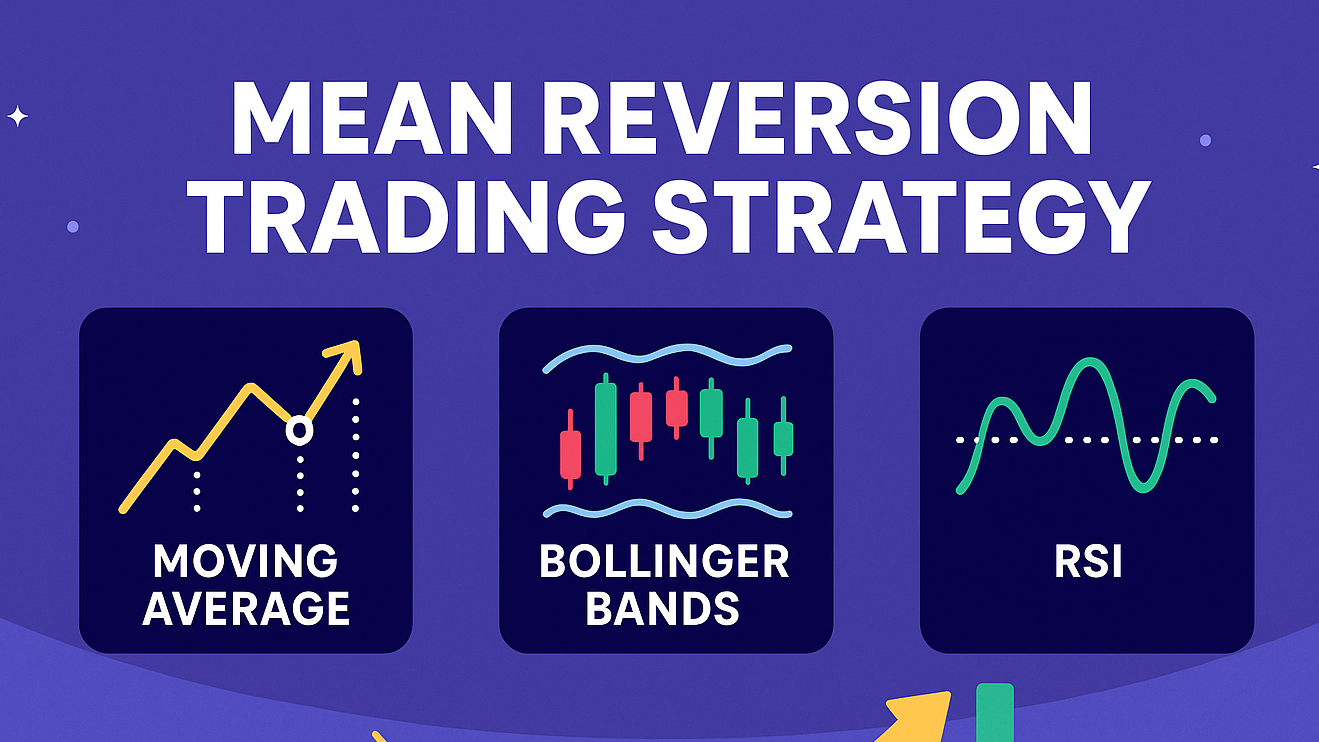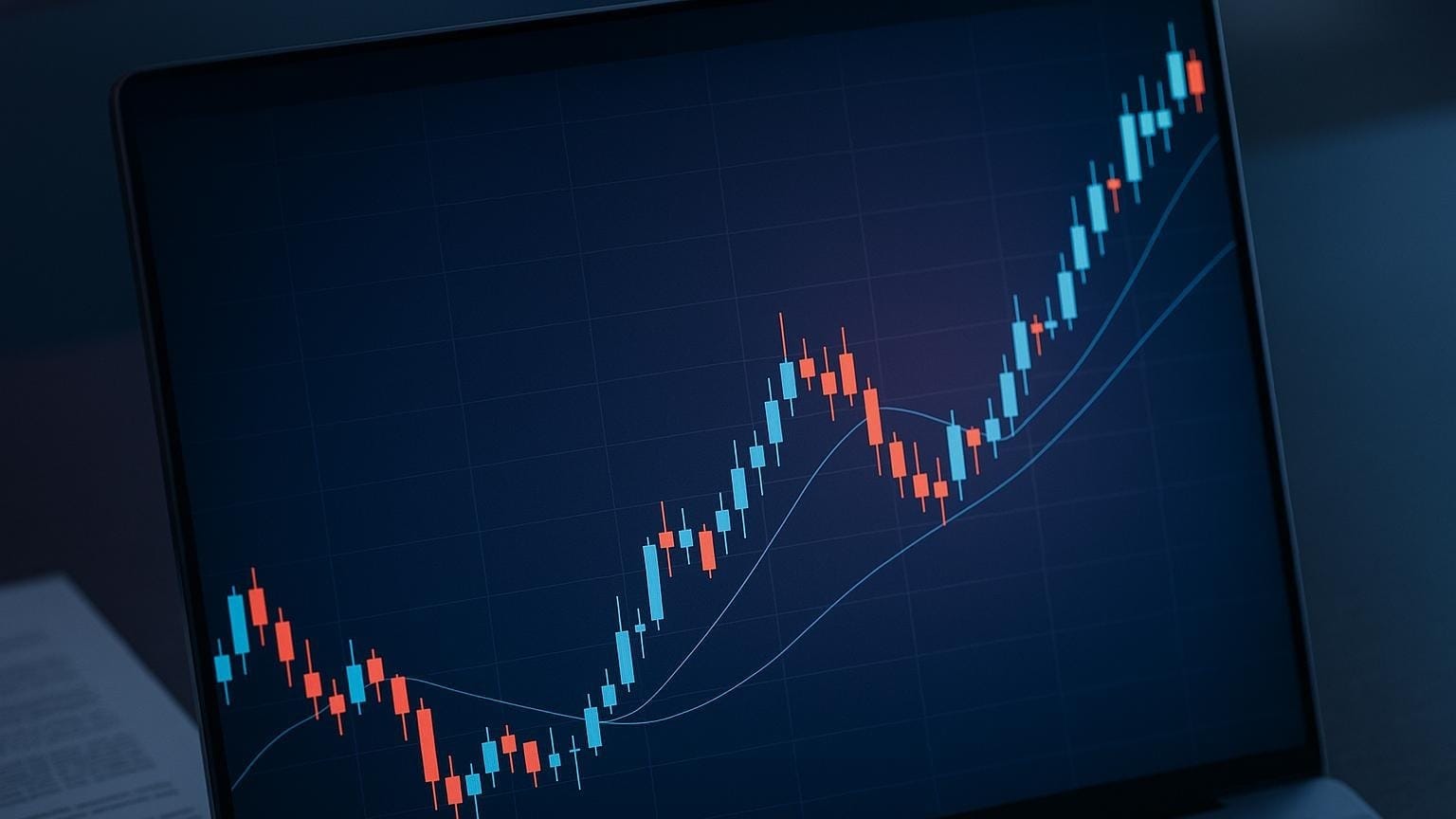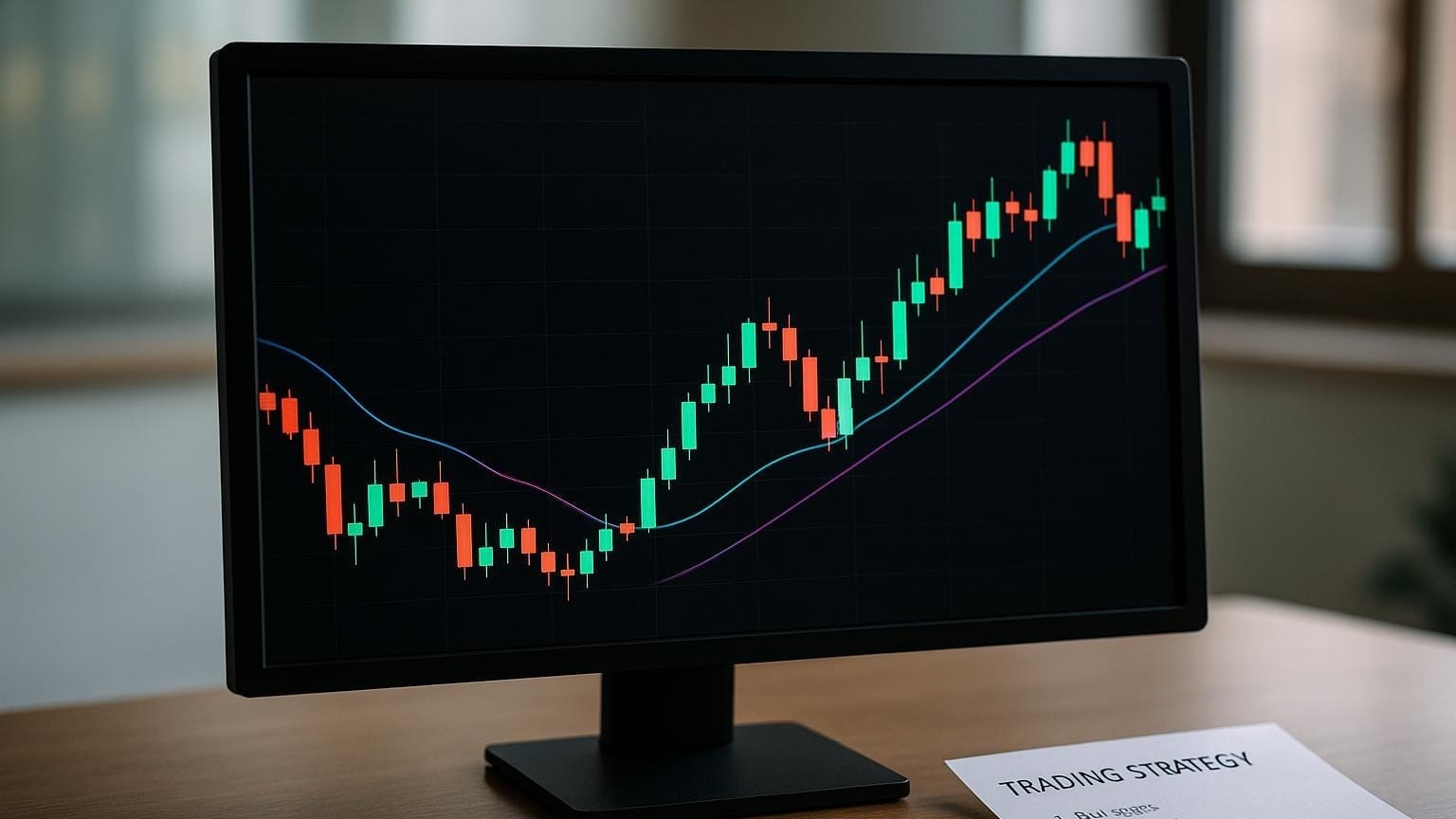Explore mean reversion strategies in algorithmic trading, focusing on key indicators, risk management, and advanced techniques for success.
Mean reversion trading focuses on the idea that prices or indicators often return to their historical averages after extreme movements. This strategy identifies overbought or oversold conditions and capitalizes on price reversals. Here’s a quick overview:
- Key Tools: Moving Averages, Bollinger Bands, RSI, Z-score.
- Signals:
- Overbought (Sell): Price above moving average or RSI > 70.
- Oversold (Buy): Price below moving average or RSI < 30.
- Pros: Clear entry/exit points, works well in range-bound markets.
- Cons: Struggles in trending markets, sensitive to news and economic shocks.
Advanced techniques include Pairs Trading, where correlated assets revert to their mean, and Kalman Filters, which adapt dynamically to market changes. Risk management is essential, use stop-loss orders and limit risk to 1 to 2 percent per trade. Backtesting and statistical validation (e.g., ADF test) are critical for success.
Quick Comparison:
| Tool/Method | Purpose | Signal Type |
|---|---|---|
| Moving Averages | Identify price deviations | Overbought/Oversold |
| Bollinger Bands | Spot price extremes | Breach of bands |
| RSI | Measure overbought/oversold | Above 70/Below 30 |
| Pairs Trading | Market-neutral strategy | Spread reversion |
| Kalman Filters | Dynamic mean reversion | Forecast errors |
This strategy works best in stable, range-bound markets. Always test thoroughly before trading live.
Algorithmic Trading Strategy [Mean Reversion] in Python using Bollinger Bands/RSI
Key Trading Indicators
Mean reversion traders rely on technical indicators to identify when prices deviate from historical averages, signaling potential reversals. Let’s break down three essential tools: moving averages, Bollinger Bands, and RSI.
Moving Average Analysis
Moving averages help traders identify price deviations from typical levels. They act as benchmarks for price trends. The two main types are:
- Simple Moving Average (SMA): Averages prices over a set period.
- Exponential Moving Average (EMA): Gives more weight to recent price data.
For mean reversion, the 10-day and 20-day EMAs are commonly used on 4-hour and daily charts. If an asset's price moves significantly above its moving average, it may signal a selling opportunity.
"Mean reversion trading tries to capitalize on extreme changes in the price of a particular security, assuming that it will revert to its previous state." – Investopedia
Here’s how price movements relative to moving averages are interpreted:
| Price Relation | Signal Type | Suggested Action |
|---|---|---|
| Far Above MA | Overbought | Consider Selling |
| At MA Level | Neutral | Wait for Signal |
| Far Below MA | Oversold | Consider Buying |
Now, let’s look at how Bollinger Bands enhance this analysis.
Using Bollinger Bands
Bollinger Bands provide a statistical framework for identifying price extremes. They consist of three components:
- A 20-day moving average (middle line).
- Two outer bands set at two standard deviations from the average.
Roughly 95 percent of price movements stay within these bands. When prices break above or below the bands, it often signals a potential reversion:
- Upper Band Breach: Indicates overbought conditions, suggesting a sell signal.
- Lower Band Breach: Indicates oversold conditions, suggesting a buy signal.
- Middle Line: Represents the mean price and serves as a target.
RSI Trading Signals
The Relative Strength Index (RSI) measures whether an asset is overbought or oversold. Created by J. Welles Wilder Jr. in 1978, RSI values range from 0 to 100. Standard thresholds are:
- Above 70: Overbought
- Below 30: Oversold
For more volatile assets, thresholds of 80 (overbought) and 20 (oversold) are often used. Here’s how RSI levels are interpreted:
| RSI Level | Market Condition | Trading Consideration |
|---|---|---|
| Above 70 or 80 | Strongly Overbought | Potential Short Entry |
| 50 | Neutral | No Clear Signal |
| Below 30 or 20 | Strongly Oversold | Potential Long Entry |
"The relative strength index (RSI) is an indicator used in technical analysis to determine overbought and oversold conditions, which provides traders with buy and sell signals (when to enter and exit positions)." – Investopedia
To improve results, combine these indicators with stop-loss orders and take-profit levels, and always backtest your strategies thoroughly.
Creating a Mean Reversion System
Developing a mean reversion trading system involves setting clear rules, managing risk effectively, and thoroughly testing your strategy.
Trade Rules Setup
A successful mean reversion strategy relies on clear, data-backed rules to identify the mean and detect significant deviations from it.
To calculate the mean, use the following:
| Timeframe | Primary Indicator | Secondary Confirmation |
|---|---|---|
| Short term (1 to 4 hours) | 20-day EMA | RSI (30/70) |
| Medium term (Daily) | 50-day SMA | Bollinger Bands (2 SD) |
| Long term (Weekly) | 200-day SMA | RSI (20/80) |
Here’s how to generate entry and exit signals:
- Buy Signal: Price hits the lower band (−2 SD) and RSI drops below 30.
- Sell Signal: Price hits the upper band (+2 SD) and RSI rises above 70.
- Exit Point: Price returns to the middle band (the mean).
Risk Controls
Once your trade rules are in place, focus on managing risk. This includes proper position sizing and dynamic stop-loss orders.
For position sizing:
- Risk only 1 to 2 percent of your total trading capital per trade.
- Adjust position size based on market volatility using the Average True Range (ATR):
Position Size = (Account Size × Risk Percentage) ÷ (Entry Price − Stop Loss)
Stop-loss orders should adjust to market conditions:
| Volatility Level | Stop-Loss Distance | Position Size Adjustment |
|---|---|---|
| Low | 1.5 × ATR | 100 percent of calculated size |
| Medium | 1.75 × ATR | 75 percent of calculated size |
| High | 2 × ATR | 50 percent of calculated size |
Testing Methods
Before using your strategy in real trading, validate it through rigorous testing. This step ensures your system is reliable and ready for different market conditions.
Key metrics to evaluate:
- Win Rate: Aim for a success rate above 50 percent.
- Risk-Reward Ratio: Target at least a 1 : 1 ratio.
Use the Augmented Dickey-Fuller (ADF) test to confirm that your chosen market demonstrates mean-reverting behavior.
Test your strategy across various scenarios:
- Low and high volatility periods
- Ranging and trending markets
- Crisis periods
Refine your system based on test results, prioritizing consistent performance and reducing drawdowns. Mean reversion strategies tend to work best in ranging markets.
Higher-Level Methods
Building on the earlier system rules and risk controls, these advanced techniques refine mean reversion strategies for improved performance and adaptability.
Pairs Trading Strategies
Pairs trading uses statistical relationships between related assets to identify mean reversion opportunities. This market-neutral strategy involves taking both long and short positions in correlated securities.
| Component | Threshold | Action |
|---|---|---|
| Correlation | > 0.8 | Consider for pair selection |
| Z-score threshold | ± 1.5 | Entry signal |
| Spread | Returns to mean | Exit signal |
Implementation steps:
- Identify co-integrated assets with a correlation above 0.8.
- Calculate the spread using a regression-determined hedge ratio.
- Enter a trade when the Z-score crosses ± 1.5.
- Exit the trade when the spread reverts to its mean.
"Pairs Trading can be called a mean reversion strategy where we bet that the prices will revert to their historical trends."
While pairs trading relies on asset correlations, the Kalman filter offers a more dynamic way to adjust to evolving market conditions.
Kalman Filter Methods
The Kalman filter provides a real-time method for tracking mean reversion, dynamically updating estimates as market conditions change. This approach is particularly useful when traditional cointegration methods struggle with shifting market relationships.
Key benefits of the Kalman filter:
- Adjusts to market changes in real time.
- Minimizes estimation errors.
- Includes built-in volatility measurement.
- Adapts to time-varying hedge ratios.
"The Kalman filter is an optimal linear algorithm that updates the expected value of a hidden variable based on the latest value of an observable variable." – Ernest P. Chan, Author
Trading signals based on forecast errors:
- Buy Signal: Forecast error significantly negative.
- Sell Signal: Forecast error significantly positive.
- Position Sizing: Scaled using the standard deviation of forecast errors.
The Kalman filter's ability to adjust continuously makes it a powerful tool, but AI applications take optimization to the next level.
AI Applications
AI enhances mean reversion strategies by improving pattern recognition and automating execution. For example, DeepSeek AI's Bollinger Bands strategy in MetaTrader 5 executed 1 275 trades, achieving a profit factor of 1.04 and a net profit of $622.
AI excels at:
- Recognizing complex mean reversion patterns.
- Optimizing the timing of entries and exits.
- Reducing execution errors.
- Adapting quickly to market changes.
Key implementation considerations:
- Regularly retrain models with updated market data.
- Ensure robust error handling and validation processes.
- Set clear risk management parameters.
- Continuously monitor and adjust performance.
Python Trading Guide
Setup Requirements
Here’s a quick rundown of the Python libraries you'll need to build a mean-reversion trading system:
| Library | Purpose | Installation Command |
|---|---|---|
| eodhd | Fetch historical market data | pip install eodhd |
| Pandas | Handle and manipulate data | pip install pandas |
| Pandas TA | Apply technical indicators | pip install pandas_ta |
| Math | Perform mathematical tasks | Built-in |
| Datetime | Work with time series data | Built-in |
Before diving in, make sure to grab your EODHD API key and set it up.
Basic Code Example
Here's a simple example of a mean-reversion strategy using AAPL stock data:
from eodhd import APIClient
import pandas as pd
import pandas_ta as ta
from datetime import datetime
# Initialize the API client
client = APIClient("your_api_key")
# Fetch AAPL stock data
aapl_data = client.get_stock_market_tick_data("AAPL", "2023-09-10", "2023-09-11")
# Create a DataFrame
df = pd.DataFrame(aapl_data)
df = df[['price', 'ts']]
df['timestamp'] = df['ts'].apply(lambda x: datetime.utcfromtimestamp(x))
# Add technical indicators
df['sma_200'] = ta.sma(df.price, length=200)
df['rsi_10'] = ta.rsi(df.price, length=10)
# Generate trading signals
df['signal'] = 0
df.loc[df['rsi_10'] < 30, 'signal'] = 1 # Long position
df.loc[df['rsi_10'] > 70, 'signal'] = -1 # Short position
This code calculates the 200-period simple moving average (SMA) and the 10-period Relative Strength Index (RSI) to generate buy or sell signals. You can expand this by evaluating the performance of these signals.
Results Analysis
Once you've implemented your strategy, it's time to evaluate its performance. Use these metrics to fine-tune and understand your results:
- Half-Life Analysis: Measure how quickly prices revert to the mean. This helps you determine the best lookback periods.
- Signal Effectiveness: Assess how well the signals perform when technical indicators hit extreme values.
- Performance Adjustments: Refine your strategy by tweaking:
- Transaction costs in your backtests
- Risk management rules, like position sizing or stop-loss levels
Be sure to test your strategy across different market conditions. Adjust parameters to see how it holds up in varying scenarios.
Wrap-Up
Mean reversion trading thrives on identifying assets that consistently return to their historical averages. This strategy works best in range-bound markets, relying on tools like Bollinger Bands, RSI, and moving averages to pinpoint entry and exit opportunities.
Main Points Review
To succeed in mean reversion trading, it's important to focus on the right tools and risk management practices. Currency pairs often show strong mean-reversion tendencies, unlike some equity indices, making market selection a key factor. These insights lay the groundwork for developing effective trading methods.
Success Guidelines
| Component | Implementation Guide | Key Consideration |
|---|---|---|
| Market Selection | Use ADF test for statistical validation | Focus on markets with steady mean-reverting behavior |
| Timeframe | Align with asset volatility | Shorter for pairs trading, longer for individual assets |
| Risk Management | Adjust position sizes based on volatility | Use dynamic stop-losses tied to ATR |
| Strategy Adjustment | Track market conditions | Shift to trend-following when mean reversion signals weaken |
Consider adding a trend filter to confirm signals and adjust the standard deviation multiplier to reflect market volatility.
"Positive expectancy means that over a series of trades, a strategy is expected to yield a net profit. It acknowledges that while individual trades may incur losses, the strategy's overall outcome is profitable." – Janne Muta








